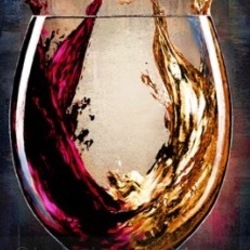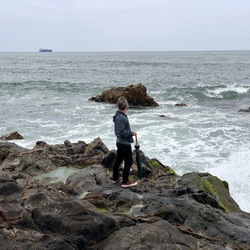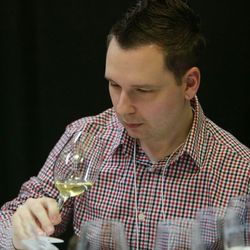Simple Truth Organic
Finca Llano Rubio
Viña Enebro Organic Monastrell
Very Simple but very satisfying 100% Monastrell. 14.5% alcohol which I usually avoid but here it works. — 8 years ago
Biohof Pratsch
Niederösterreich Rosé Blend
Fun stuff from Austria. Simple but so drinkable. Nice acidity. Fresh. Organic grapes. 12% — 8 years ago
M. Chapoutier
Les Meysonniers Crozes-Hermitage Blanc Marsanne 2015
Canteloupe, honeydew, lime zest. Great mineral qualities and none of the overzealous malolactic notes often found on Marsanne. Simple and unspoiled organic wine. No new oak, 10% old oak. Harvested early due to the unusually hot season. — 9 years ago
Amastuola
Organic Farm Primitivo
So delicious and simple. — 9 years ago
Azienda Santa Barbara
Verdicchio dei Castelli di Jesi 2014
Very good, luscious well rounded fruit forward white with impressionable minerality. Tastes of the earth like biodynamic or organic wine. Have to track this down for simple weekday suppers. — 10 years ago
Bonterra Vineyards
Mendocino County Zinfandel 2012
Moderate tannins, good Zin flavor, evenly dry, simple finish, organic, great mid palate and robust. — 10 years ago
Tenuta Sant'Antonio
Télos Il Bianco Veneto Garganega Chardonnay Blend 2013
Crisp, mineral, simple and fresh fully organic Veneto Chardonnay, a true delight for a summer day! #wine #wineporn #veneto #organic #organicwine #biodynamic — 10 years ago

Candoni
Organic Merlot
Mild. Simple. Easy. — 11 years ago
Emiliana Organic Vineyards
Silbador Valle de Colchagua Carménère 2011
An amazing new find- one of the best Chilean organic wines! Light but not simple, fruity with a lingering aftertaste. — 12 years ago
Raimat
Boira Garnacha
Simple and I like it. Perfect for the price, I’d say. Aniseed is the most compelling tasting note. Okay truth? I’m a NUT for anything absinthe-y. Which is to say I like black jellybeans, caraway, in theory licorice (yet somehow I don’t like black twizzlers—texture?), chervil and tarragon and...Garnacha that is anise-y. As this is so it has my heart. It has a smidge of cocoa and tobacco on the end. I dunno I dig. — 7 years ago
Parish Brewing Company
DDH Blood Orange Envie American Pale Ale
A dirty, danky, organic and unpolished feel, and all the better for it. Parish has mastered the ability to make core flavor profiles in such a pure and precise manner that the absence of distraction allows in so much secondary depth and tertiary nuance. Bitter, concentrated juice, pine and mint, mango, strawberry, and pineapple, pith and peel, and all with a nostalgic Cap’n Crunch backdrop. Really simple and really stunning. — 8 years ago
Samuel Tinon
Birtok Dry Tokaji Fumint 2014
On the nose; lemon, grapefruit, light petro, wet wool, smokey notes, saline and white & yellow lilies. The body is creamy. Notes of; smoke, saline, lemon & lime juice inferior melon, mix of ripe & underripe pineapple, light honey notes, soft, silty volcanic minerals, dry top soil dust, big round acidity with a round fruity mineral driven finish. Pair with simple meats, veggies, curry and dry cheeses, green salad. Producer notes...the winery is located in the village of Olaszliska just north of the village of Tokaj near the banks of the famous Bodrog River. Samuel farms roughly 5 hectares in this area (Határi vineyard) and an additional couple of hectares on the slopes of Mt. Tokaj. The soils on Határi are volcanic based (tuffa, obsidian), broken up limestone and clay. Most of their plantings are 90% Furmint and 10 % Hárslevelű...some as old as 90 years. They are mostly organic as no herbicides or pesticides are used. Grapes are pressed in a pneumatic press and fermentation is in Hungarian oak barrels. No new oak is used. Photos of; Samuel Tinon, the descent into their ancient cellars and resting Tokaj cellar bottles. — 8 years ago
Francisco Gomez
Organic Farming Fruto Noble Alicante Sauvignon Blanc
Simple. Perfect. Local. Ahhhhh — 9 years ago
Cédric Bouchard
Roses de Jeanne Côte de Béchalin Brut Blanc de Noirs Champagne Pinot Noir
2008
Varietals: Pinot Noir
Organic: Practicing
Vineyard: 1.5 hectare vineyard in the lieu-dit Cotes de Bachelin, consisting of 100% Pinot Noir. 25 hl/h.
Soil: Bands of Kimmeridgian soil common to Chablis. The Côtes des Bars is closer to Chablis than to Reims.
Viticulture: Vineyards are farmed using organic methods and simple Guyot pruning is employed. Vines are planted at a density of 8000 vines per hectare.
Vinification: 1st press juice only, hand harvested and crushed by foot and fermented using indigenous yeast. Bottled unfined and unfiltered.
Aging: Cédric gives La Parcelle the longest aging regimen of all his wines. This wine is unfined, unfiltered, and aged for 80 months. zero dosage.
Notes: 1.5 hectare vineyard in the lieu-dit Cotes de Bachelin, consisting of 100% Pinot Noir. 25 hl/h.1st press juice only, hand harvested and crushed by foot and fermented using indigenous yeast. Cédric gives La Parcelle the longest aging regimen of all his wines. This wine is unfined, unfiltered, and aged for 80 months. — 10 years ago
Tentaka Shuzo
Organaka Organic Junmai Sake 2012
Soft, fresh and clean with unripe honeydew notes. Pleasant. Can pair with simple fair. — 10 years ago
Antonio J. Lopes Ribeiro
ALR Vinho Verde White Blend 2013
A great Vinho Verde with a touch of Dao style ( the winemakers make wine mostly in the Dao region normally Casa de Mouraz, great organic producer) , more modern, this mix of Vinho Verde grapes (Loureiro, Tradjadura, Azul and Arinto) deliversa nice VinhoVerde with florals, limes and no fizzy effect as many low range VinhoVerde wines. Fresh, simple and classic — 10 years ago
Bodega Santa Julia
Organic Mendoza Malbec 2013
A delicious malbec. Truth: after 4 Jamesons, my palate isn't the most impressive but I did thoroughly enjoy. — 11 years ago
Funaro
Nero d'Avola 2017
Sometimes you just can't beat the basics. #sicilydoesitbetter #italianisalwaysbetter #evenbetterwithnerodavola #italywine 🇮🇹
Simple, perfect work - no bling, no chichis, just pure organic fruit juice with a pinch of Sicily (Santa Ninfa) 🇮🇹 — 7 years ago
Château Lafite Rothschild
Carruades de Lafite Pauillac Red Bordeaux Blend 2003
On the nose, ripe; blackberries, sweet & sour dark cherries, cooked cherries & strawberries & hues of blueberries. Black tea, cola, soft baking spices; vanilla, light clove & cinnamon. Crushed rocks, stones, limestone, turned, moist black earth, tobacco leaf, saddle-wood, soft leather, dry & fresh dark red florals.
The body is medium edging toward full. The tannins pretty well resolved. The ripe fruits show the hot, ripe vintage. Blackberries, sweet & sour dark cherries, cooked cherries & strawberries & hues of blueberries black tea, cola, soft baking spices; vanilla, light clove & cinnamon. Crushed rocks, stones, limestone, tobacco with ash, some graphite, soft medium dark spice, turned, forest floor, powdery but edgy minerals, saddle-wood, soft leather, dry & fresh dark red florals with some violets on the finish.
This showed better with Ribeye. The Ribeye brought out a fuller, richer wine with even more complexity. 9.35-9.4 with the Ribeye. It just missed 9.2 on its own. It’s big brother the 03 “Lafite” is 💯 point Parker wine.
Photos of; Chateau Lafite, their oak vat fermenters, Estate wine and their magnificent barrel room.
Interesting history and producers notes...Lafite Rothschild has a long and interesting history dating back to 1234, even though the property was not in the Bordeaux wine business at that time.
It is has been largely believed that vines were already planted on their terroir. The owner of the estate at the time, Gombaud de Lafite left his mark, his name. Almost 1,000 years after he owned it, the Chateau is still named after him! The vines were probably in existence at Lafite for over a century, it was not until around 1680, the majority of vineyards of what we know of as Lafite Rothschild today were created. This is because on the 1680 estate manifest, there are six mentions of their Bordeaux vineyards. Jacques de Segur, earns credit for cultivating the vineyard as I wrote in my Colon Segur post last weekend. In 1695, Alexandre de Segur married Marie-Therese de Clauzel, heiress to Chateau Latour. So to dovetail that write up, within a generation, the Segur family married into two of the greatest Bordeaux vineyards, Chateau Lafite and Chateau Latour! When their son, Nicolas-Alexandre passed away, Chateau Lafite and Chateau Latour were separated.
In 1797, Chateau Lafite was sold again. In the deed of sale, Chateau Lafite was described as a Premier Cru of Medoc. This is one of the earliest mentions of what we know of today as Lafite Rothschild producing wines of what would later be classified as an 1855 First Growth.
At that time, of Lafite were managed by the Goudal family. The Goudal family were wine historians and were able to read accurate records and details of the viticulture and marketing plans for Chateau Lafite in the estates formative years. The Goudal family gets the credit for creating the cellar and saving many of the oldest bottles that remain in the cold, dark cellars, including their oldest bottle, the 1797 Lafite!
The start of the famous Rothschild family begins in 1744, with the birth of Amschel Meyer. Amschel Meyer began creating his fortune while working as a merchant at “Zum Roten Schild,” which eventually became the family name of Rothschild.
In 1798 his sons were sent to various cities to create their fortunes. Needless to say, his sons all prospered as did their children in turn. This eventually led to them wanting to own a Chateau in Bordeaux. So in 1853, Baron Nathaniel de Rothschild, an English member of the Rothschild family, purchased Chateau Brane-Mouton. As was the custom of the day, the new owner renamed it using his name and Chateau Mouton Rothschild was born.
This was followed in 1868, when James Rothschild, another member of the family purchased Chateau Lafite, which was now a coveted First Growth.
On 8 August, 1868, Baron James d’Rothschild purchased Chateau Lafite, which was sold at a public auction in Paris. It’s assumed, he bought the property for family competitive reasons looking to one up his brother, the owner of Mouton Rothschild. At that time, Mouton Rothschild was only a Second Growth at the time. But, that does not paint the entire picture. The 1855 Classification had not taken on the importance associated with it the we see it today. Plus, buying Lafite was a reasonable investment as the vineyard sold for about 8 times its earning potential.
The actual Chateau is one of the older structures in Bordeaux, as part of the building dates back to the later part of the 16th century. In 1868, the vineyard took up 135 hectares, of which 74 hectares were cultivated with vines. Production was much smaller in those days than it is today as it was between 4,000 and 5,000 cases.
Just three months after the purchase, Baron James d’Rothschild passed away and Chateau Lafite Rothschild became the joint property of his three sons; Alphonse Rothschild, Gustave Rothschild & Edmond Rothschild. Since 1868, Chateau Lafite Rothschild has remained in the hands of the of Rothschild family. The new owners renamed the estate Chateau Lafite Rothschild.
Jumping ahead to the modern age, in 1962, the Rothschild family added to their holdings when they purchased Chateau Duhart-Milon, a Fourth Growth vineyard also located in Pauillac. It was owned by the Casteja family for more than a century, Chateau Duhart Milon suffered from neglect and was in a awful condition. By the time Duhart Milon was obtained by the Rothschild family, the vineyard was down to only 17 hectare which required extensive renovations.
Baron Eric Rothschild, nephew of Baron Elie Rothschild, took over the management of Lafite Rothschild in 1974. Baron Eric Rothschild was part of the fifth Rothschild generation to inherit Chateau Lafite Rothschild. In 1984, the Rothschild family added to their holdings in Bordeaux with the purchase of Chateau Rieussec in Sauternes.
1987 was a difficult vintage, but because that was the year Lafite celebrated the inauguration of their wine new cellar, they had a lot to be excited about.
The new cellars were built under the supervision of Catalan architect Ricartdo Bofill, is both underground and circular, with a vault supported by 16 columns, giving the structure a majestic architectural style. The cellar holds 2,200 barrels, which is about 55,000 cases of wine. The construction took two years to finish and was completed in 1988.
Domaines Baron Rothschild became one of the first Bordeaux properties to invest in South America when they purchased Vina Los Vascos from a Chilean family. The owners of Lafite Rothschild continued expanding their holdings with the purchase of Chateau lEvangile in Pomerol from the Ducasse family, who owned the property for almost 100 years.
The wine making at Chateau Lafite Rothschild was managed by Charles Chevallier, who began his position in 1994. Charles Chevallier was replaced by Eric Kohler in January 2016. 2017 saw another change at the estate when Jean Guillaume Prats replaced Christopher Salin as the President of Domaines Baron Rothschild.
Perhaps, it’s the most refined of the First Growth. The wine, like all First Growth’s takes decades to mature. It has remarkable staying powers. Bottles of 1870 Lafite Rothschild discovered in the Glamis castle remain profound at more than 140 years of age! It is consider by many Master Sommeliers to be the best wine in the world.
Chateau Lafite Rothschild is one of the earliest major Bordeaux estates to bottle their own wine. In 1890, they bottled a large portion of the wine and again in 1906. Part of the estate bottling was due to requests from Negociants who were willing to pay more for Chateau bottled wines. Also, bottling was primarily done to combat piracy. At the time, it was known that merchants in some countries, like Russia were bottling cheap wine and placing labels from Lafite Rothschild on the bottles. The Koch’s famous Jefferson bottles were not the first attempt at counterfeiting.
Prior to 1996, some would say the property had its share of ups and downs. The 1960’s and 1970’s were not great for Chateau Lafite Rothschild. But since 1996, Lafite Rothschild has been producing some of the best wine in their history!
Sadly, only the wealthy can afford to purchase it. Price aside, there is no denying the level of quality. In 2003 Lafite Rothschild produced a wine that is possibly unequaled by the estate at any time in their long history. Hence, my purchase of their 03 second wine. 2009, 2010 and 2016 are not far behind.
Starting in about 2008, Lafite Rothschild became the most collectible wine from Bordeaux. Prices exploded due to demand from China as Chinese businessmen bought them as gifts or bribes depending on you look at it.
The reason this started was Lafite Rothschild paid for product placement on the number one rated Chinese soap opera on television. Characters in that show were pictured enjoying life with Lafite Rothschild and since then demand went through the roof as did priced.
However, Issac Newton had it right when he declared “What goes up, must come down.” Prices for Lafite Rothschild plummeted after 2011. By the difficult 2013, prices were finally starting to hold firm, but many of the vintages that were setting price records on a daily basis had lost close to 50% of their value.
Starting with the 2012 vintage, Chateau Lafite Rothschild began instituting anti-counterfeiting measures. From 2012 forward, to help fight, rampant counterfeiting, the estate places a seal of authenticity on the capsules of both Lafite Rothschild and Carruades de Lafite. The seal features a unique, numbered code that can be checked on their website, to verify if the wine is real.
The 112 hectare vineyard of Chateau Lafite Rothschild is planted to 70% Cabernet Sauvignon, 25% Merlot, 3% Cabernet Franc and 2% Petit Verdot. This shows a slight change in the vineyard.
While Cabernet Sauvignon remained at 70%, today there is slightly more Merlot, less Cabernet Franc and the Petit Verdot has been added since the mid 1990’s.
Located in the far north of the Pauillac appellation, only the small, Jalle de Breuil stream separates the vineyards from St. Estephe. You could divide the vineyards of Chateau Lafite Rothschild into three sections with 100 separate parcels in all. The estate has close to 50 hectares of vines located close to the Chateau, on both sides of the D2, which offers gentle rises in elevations of up to 27 meters. They also have about 50 hectares vines planted on the plateau in the Carruades sector, where they have two blocks of vines, one of which is inside the vineyard of Chateau Mouton Rothschild. It is interesting to note that even though the parcels in the Carruades sector give their name to the second wine of the estate, those vines are almost always placed in the Grand Vin.
There are also vines adjacent to, and interspersed with the vineyards of Chateau Duhart Milon. The property also consists of a smaller, 4.5 hectare parcel of vines located in the Saint Estephe appellation, “La Caillava”. The vines in St. Estephe are situated not that far from Cos d Estournel, which are located on a larger a parcel known as Blanquet. The vines in Saint Estephe are allowed to be placed into the wine of Chateau Lafite Rothschild because those vines were used to produce Lafite in 1885, at the time of the classification. The vineyards are close to their famous neighbor Mouton Rothschild.
Located just south of the Chateau, the best terroir of Lafite Rothschild has a thick layer of gravel with sand, clay, marl and limestone in the soils with rolling, gravel slopes. The gravel can be as deep as 4 meters in some parcels.
It is important to note that even though their vineyards are in the far north of Pauillac, most of the soil is pure gravel, rocks and stones. With more than 50% of the soil consisting of gravel, that is a large part of the reason Lafite Rothschild has such elegant, feminine textures and that coveted sensation of minerality.
On average, the vines are close to 40 years of age. However, Chateau Lafite Rothschild has much older vines. In fact, they have some vines that are more than 100 years of age planted in the La Graviere section. That small parcel of Merlot vines dates back to 1886. Less than 1% of the vines are that old.
Additionally, they have a small section of Cabernet Sauvignon that dates back to 1922! Other old vines range from 50 to 90 years of age! They also maintain some of the oldest Petit Verdot vines in the Medoc that was planted in the early 1930’s.
At Chateau Lafite Rothschild, between 1% to 1.5% of the vineyard is replanted every year. Vines less than 20 years of age are never included in the Grand Vin.
The vineyard of Chateau Lafite Rothschild is planted to a vine density that ranges from 7,500 to 8,500 vines per hectare. Only organic fertilizers are used in the vineyards of Lafite Rothschild.
During harvest, the goal is not to pick at the maximum level of ripeness. Instead, they are seeking a blend of grapes at differing levels of maturity, which gives the wine its unique textures, freshness, aromatic complexities and elegant sensations.
Lafite Rothschild is the largest of the First Growth vineyards with close to 112 hectares of vines. A large portion of the estate is taken up with stunningly, beautiful landscaping, lakes, trees and parkland.
At one point in time, Chateau Lafite Rothschild produced a dry white, Bordeaux wine that was sold as Vin de Chateau Lafite. The wine was produced from a large percentage of Semillon, blended with a small amount of Sauvignon Blanc. The last vintage for their white wine was 1960. The wine was sold as a generic AOC Bordeaux blanc with a simple, scripted label, black and white label.
Lafite vinification takes place in 66 vats that are a combination of 29 wood vats, 20 stainless steel tanks and 17 concrete vats that range in size from as small as 45 hectoliters up to 123 hectoliters in the concrete and as large as 270 hectoliters for the wood. The wide range of vat sizes coupled with different materials allow Chateau Lafite Rothschild to vinify depending on the needs of each specific parcel and grape variety. The stainless steel tanks and oak vats are used for Cabernet Sauvignon. The Merlot is vinified in the concrete tanks. Malolactic fermentation occurs in smaller, stainless steel tanks that vary in size from 25 hectoliters up to 60 hectoliters. At this point, Chateau Lafite Rothschild does not yet use gravity to move the fruit and juice in the cellar. It’s a good bet that a remodel is coming soon.
The average annual production of Chateau Lafite Rothschild ranges from 15,000 to 20,000 cases of wine per year, depending on the vintage. They of course make this second wine, Carruades de Lafite, which due to the name and association with the Grand Cru, has also become extremely collectible. Carruades de Lafite takes its name from a specific section of their vineyard that is located near Mouton Rothschild. Carruades is actually one of the older second wines in Bordeaux, as it was first produced in the mid 1850’s. About 100 years later during the mid 1960s, the estate reintroduced their second wine naming it Moulin de Carruades. The name was changed again in the 1980’s to Carruades de Lafite.
There is also a third wine which is sold as an AOC Pauillac that is produced from declassified fruit from Lafite Rothschild and Duhart-Milon.
The blend for Chateau Lafite Rothschild changes with each vintage depending on the character and quality of the vintage. Generally speaking, the amount of Cabernet Sauvignon in the blend ranges from 80% to 95%. Merlot is usually 5% to 20%. Cabernet Franc and Petit Verdot usually varies from 0 to 5%.
— 7 years ago



















Marshall Todd Herron DPM
Cacique Maravilla Pipeno Pais 2016. These grapes are 100% organic wine. The soil has never been contaminated with pesticides. When I poured it from my coravin it bubbled in the glass. The color is almost like a pink sparkling wine. And the bouquet is sparkly fizzy fun on my nose. The initial bouquet is not far behind with a light tingle on my tongue. However this is a dry wine. It is very light with cherry and cranberry fruit. It is a very simple wine. The mid-palate loses all the fizz and flows into a nice semi dry finish. There are Earth tones and oak on the mid palate as well!!!!! This would be awesome slightly chilled to about 52 degrees on a hot day. — 7 years ago